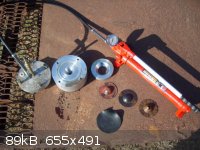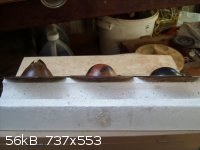Fulmen
International Hazard
    
Posts: 1693
Registered: 24-9-2005
Member Is Offline
Mood: Bored
|
|
Funnel/trumpet liner vs straight cone?
Well my experiments with deep drawing are progressing nicely, so I need to make some choices on the tooling.
I'm leaning against a funnel shaped (cone with cylindrical stem) liner rather than a straight cone, partly because I find the tooling easier to make
and partly because they should perform better. I know a funnel shape isn't exactly like a trumpet, but the principle should be the same right?
But how long should the stem be and should it be open or closed?
The liners I'm working on are 15mm OD, 0,5mm thick and the stem ID is probably limited to 4mm (although I will try smaller). Any opinions?
|
|
|
Fulmen
International Hazard
    
Posts: 1693
Registered: 24-9-2005
Member Is Offline
Mood: Bored
|
|
Nothing? Not a single thought?
Meanwhile, work is progressing slowly. From a 28x0,5mm blank (disk) I've managed to draw down to 6mm OD without tearing (barely), not sure how to
progress form here. The dies are of pretty mediocre quality, it's hard to get good surface quality when using countersink cutters. Turning is better
but hard to accomplish on such small diameters, guess I'll have to grind some custom tools for this.
One solution would be to up the size, a 6mm stem wouldn't be so bad on a 25-30mm cone. But I like to keep things small if possible.
|
|
|
CaliusOptimus
Hazard to Self
 
Posts: 96
Registered: 10-6-2011
Member Is Offline
Mood: Subjectively Objective
|
|
I've been working on something that seems to be a really good alternative to drawing the liner. You will probably still need a lathe at your disposal
to get good results. The blank was cut out of sheet with tin snips. I drew the blank shape in corel draw.



I can't wait to try it! Just gotta solder up the cracks....I think I'm going to press it full of ETN. Cone dia is 1.125"
[Edited on 1-9-2012 by CaliusOptimus]
|
|
|
Fulmen
International Hazard
    
Posts: 1693
Registered: 24-9-2005
Member Is Offline
Mood: Bored
|
|
Let us know how it works, I played with the same thing but never got any results worth trying.
|
|
|
nitro-genes
International Hazard
    
Posts: 1048
Registered: 5-4-2005
Member Is Offline
|
|
When made properly, I think the cylindrical stem shape at the apex of the liner might indeed improve penetration. This is because the tip of the liner
doesn't add much to the formation of the jet and at the same time produces a more plain shockwave through the explosive after initiation. IIRC, for a
cone shaped liner with a hole in the apex of 10% of the total liner diameter performs optimal. (25% for hemispherical liner). For stem designs I'm not
sure though. Don't think length is that important, as long as it extends about 0.5 CD's from the base of the liner and initation is right on top of
the stem. :-)
[Edited on 2-9-2012 by nitro-genes]
|
|
|
gnitseretni
Hazard to Others
  
Posts: 280
Registered: 5-1-2007
Location: Medellin
Member Is Offline
Mood: No Mood
|
|
0.5 CD from base of the liner? Surely you meant to say from TIP of the liner? 0.5 CD is very little though. I thought optimum head height was
something like 1.7 CD. Probably best to go even higher than that in our homemade charges. Better too much than to little.
|
|
|
Fulmen
International Hazard
    
Posts: 1693
Registered: 24-9-2005
Member Is Offline
Mood: Bored
|
|
That's my understanding as well. A rounded tip may produce a jet, but it will be more of a slow slug and quickly intercepted by the faster jet
produced by the conical section, in fact I believe this has been captured on photos as a mushroom-shaped "head" early in the jet formation as the
faster jet "shoots through" the initial slug.
If I understand it correctly one of the main benefits of a trumpet liner is the higher velocity gradient of the jet, this reduces the needed standoff
as it stretches faster. Could this also improve jet coherency with cruder made charges?
| Quote: |
IIRC, for a cone shaped liner with a hole in the apex of 10% of the total liner diameter performs optimal. (25% for hemispherical liner).
|
I've always had a bad feeling about open liners, I would have thought that the explosion products could interfere with jet formation but there's no
point in arguing against proven results. Sounds like an open-ended funnel might be the best choice, I'll start reworking the dies tonight and see what
I can do.
[Edited on 2-9-12 by Fulmen]
|
|
|
Fulmen
International Hazard
    
Posts: 1693
Registered: 24-9-2005
Member Is Offline
Mood: Bored
|
|
Well I tried to improve my dies but no luck, I seem to have hit the limit at 6mm. It might be a limit of the drawing process or I may simply not
understand it well enough. I did some trials on swaging the stem further down, and it shows some promise although I can't be sure before I make some
better tooling. I don't like how the material flows back towards the cone, but I don't see any other way of doing this. Hopefully I will be able to
press the cone back into even thickness, or perhaps I should look for a tapered body?
|
|
|
CaliusOptimus
Hazard to Self
 
Posts: 96
Registered: 10-6-2011
Member Is Offline
Mood: Subjectively Objective
|
|
Have you been annealing the copper at all?
|
|
|
Fulmen
International Hazard
    
Posts: 1693
Registered: 24-9-2005
Member Is Offline
Mood: Bored
|
|
I've tried but it didn't make any difference.
|
|
|
watson.fawkes
International Hazard
    
Posts: 2793
Registered: 16-8-2008
Member Is Offline
Mood: No Mood
|
|
Quote: Originally posted by Fulmen  | | It might be a limit of the drawing process or I may simply not understand it well enough. I did some trials on swaging the stem further down, and it
shows some promise although I can't be sure before I make some better tooling. |
I can't say I'm an expert on
drawing or swaging particularly, but I understand that there's a flow regime that requires some minimum pressure, which is why you see all sorts of
heavy machinery in a press shop. What are you using to exert pressure?
You mentioned annealing the copper. What's the treatment you're using?
|
|
|
CaliusOptimus
Hazard to Self
 
Posts: 96
Registered: 10-6-2011
Member Is Offline
Mood: Subjectively Objective
|
|
For the pics I posted earlier: Pressed with 35g of ETN, I got about 2.2CD of penetration into cast iron. Stand-off was 2CD.
Also, liner angle was 82deg.
[Edited on 4-9-2012 by CaliusOptimus]
|
|
|
Fulmen
International Hazard
    
Posts: 1693
Registered: 24-9-2005
Member Is Offline
Mood: Bored
|
|
It doesn't take much force, the 5ton press I use is more than enough. It might be that I try to draw too much in each step, I've tried reading up on
the limitations of drawing but it's not something you can learn fully in a few days. The annealing was simply done by heating with a butane torch...
|
|
|
watson.fawkes
International Hazard
    
Posts: 2793
Registered: 16-8-2008
Member Is Offline
Mood: No Mood
|
|
Quote: Originally posted by Fulmen  | | It doesn't take much force, the 5ton press I use is more than enough. [...] The annealing was simply done by heating with a butane torch...
|
My recollection is that cracking is more likely in pressure regimes less than some critical value, which is
the reason for very fast presses, so that time spent in the lower-than-critical pressure regime is minimized. Mind you, I can't recall exactly why I
think this, so take it for what it's worth.
As for annealing, as long as you stay at annealing temperature for long enough, you'll be OK. Too-long annealing can lead to large grain size, which
I'd have to guess is undesirable for this application. This is one of the reasons for quenching (which does not harden copper, unlike steel), to lock
in the grain size before it grows more. Quenching copper in plain water is fine.
|
|
|
Fulmen
International Hazard
    
Posts: 1693
Registered: 24-9-2005
Member Is Offline
Mood: Bored
|
|
Interesting, but the problem isn't really cracking but rather thinning at the punch nose that causes it to tear.
|
|
|
watson.fawkes
International Hazard
    
Posts: 2793
Registered: 16-8-2008
Member Is Offline
Mood: No Mood
|
|
Quote: Originally posted by Fulmen  | | Interesting, but the problem isn't really cracking but rather thinning at the punch nose that causes it to tear. |
Tearing and cracking are pretty much the same thing in this context. Both have a propagating defect that causes lengthening of a
rupture. The net forces acting on the defect are what matters. Reducing those forces is one way to deal with it. Without having seen your tooling nor
the failed material, I can only surmise that you have a sharp tipped punch. In that light, I'd suggest using a two-step press process. First press
with a blunt-tipped punch, to form the bulk of the metal with less stress at the apex. Then press with a sharp point on the pre-form; you'll be moving
less metal and there will be less total force around the tip to cause tearing.
|
|
|
Fulmen
International Hazard
    
Posts: 1693
Registered: 24-9-2005
Member Is Offline
Mood: Bored
|
|
I think of a crack as more abrupt than thinning/tearing, but that's mainly semantics. Don't have a pic of the fault now, but here's a drawing of the
tooling. I draw in steps, from a 28mm disk to a 15mm cup, then to a cone with a 10, 8 and 6mm stem. That's when the thinning at the punch nose occurs.

|
|
|
watson.fawkes
International Hazard
    
Posts: 2793
Registered: 16-8-2008
Member Is Offline
Mood: No Mood
|
|
Quote: Originally posted by Fulmen  | | I draw in steps, from a 28mm disk to a 15mm cup, then to a cone with a 10, 8 and 6mm stem. That's when the thinning at the punch nose occurs.
|
Just to check, are you annealing between steps?
|
|
|
Fulmen
International Hazard
    
Posts: 1693
Registered: 24-9-2005
Member Is Offline
Mood: Bored
|
|
I've tried both without any change in result. I can draw down to 8mm without annealing, but either way I get tearing at 6.
|
|
|
nitro-genes
International Hazard
    
Posts: 1048
Registered: 5-4-2005
Member Is Offline
|
|
What is the thickness of the copper after drawing? The pointier the shapes you draw, the more one part of the plate is streched maybe? You may need to
start with thicker plate, or only thicker near the center, where the stem is formed.
Here is the open pole liner article, tons of useful information here.
www.dtic.mil/cgi-bin/GetTRDoc?AD=ADA229151
edit: Oh and yes I meant the tip of the liner of course...:-)
[Edited on 9-9-2012 by nitro-genes]
|
|
|
gnitseretni
Hazard to Others
  
Posts: 280
Registered: 5-1-2007
Location: Medellin
Member Is Offline
Mood: No Mood
|
|
Any updates, Fulmen? Was wondering if you managed to make liners with your method. I'm looking for a different way to make liners as the one I tried
(hydroforming) didn't work so well (especially now that my pump is broke). And electroforming, although it works well, it's slow. I might use the die
for some explosive forming 
 
|
|
|